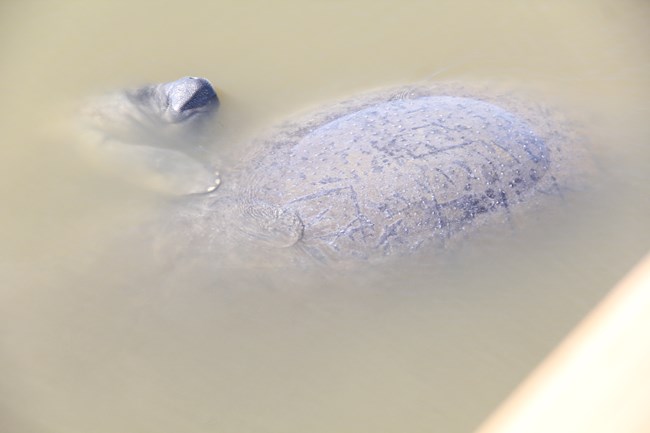
NPS Photo West Indian Manatee (Threatened)Canaveral National Seashore has a number of unusual and interesting aquatic and terrestrial mammals. One is the West Indian Manatee (Trichechus manatus), a federally endangered species, that can be found in Mosquito Lagoon. Approximately 5,000-6,000 manatees are estimated to occur in the entire state. Also known as the sea cow, adults typically weigh 800 - 1200 pounds and are about 10 feet long. They spend much of their time grazing on seagrass and other plants, consuming up to 10-20 percent of their body weight per day. Calves can often seen with the cows since they nurse up to one or two years of age. If you are fortunate enough to see one nursing, you will notice that the cow's mammary glands are located at the base of the flippers. Like other large mammals, manatees reproduce very slowly, bearing one calf at a time and investing considerable time with each offspring.
Manatees use the west side of Mosquito Lagoon, along the intercostal Waterway, as a corridor to move north and south. Pockets along the east side are used for resting and foraging. During colder months, manatees leave the lagoon, seeking warmer water to the south or freshwater springs along the St Johns River. However, up to 100 opportunistic individuals remain nearby by taking advantage of warm water discharges at two power plants along the Indian River near Titusville. These areas are not open to the public, but good locations to look for manatees during warmer months (March to mid-November) are the Apollo District Visitor Center dock and the Haulover Canal manatee overlook along State Road 3. Be patient if you don't see one at first. If they are present, they will soon surface to breathe - about every four minutes when resting and as little as every 30 seconds when very active. Sometimes only the tip of the snout and the nostrils is visible but at other times the head, tail, back can be clearly seen. Most manatees have obvious scars from boat propellers. These marks are photographed and used by researchers to identify individual animals. Laws to protect manatees in Florida were enacted as far back as 1893; however, mortality rates remain high for an animal with such a low reproductive rate. Collisions with boats, flood control structures, entanglement in fishing gear, cold weather and ingestion of red tide are all causes of death. Increased public awareness and appreciation are the key to survival for this gentle giant. 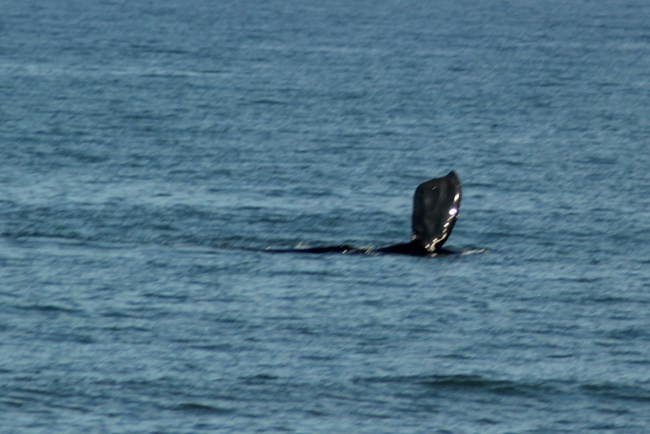
NPS Photo North Atlantic Right Whale (Endangered)
The north atlantic right whale (Balaena glacialis) which utilizes the coastal waters of Georgia and northeast Florida in the winter as a calving ground for pregnant females and a foraging area for juveniles. It is the most endangered whale species in the western North Atlantic. If you visit between December and March, keep an eye on the horizon offshore for one of these special animals. If you do spot one, be sure to inform the park staff so they can alert other visitors. Since collisions with ships is the greatest threat to the species, large vessels now report when entering whale calving grounds and in turn receive information on any whales in the area. Ship strikes are the leading cause of death for the endangered North Atlantic right whale. Entanglement in fishing gear is also cause of death. Right whales are monitored from Florida up to the Gulf of Maine. 2017 marked an in crease in boat strikes and entanglements equaling 17 deaths. In 2018 (3), 2019 (10), and 2020 1 death. The 2017 deaths were labeled an unusual mortality event. According to NOAA, “Under the Marine Mammal Protection Act, an unusual mortality event (UME) is defined as "a stranding that is unexpected; involves a significant die-off of any marine mammal population; and demands immediate response." 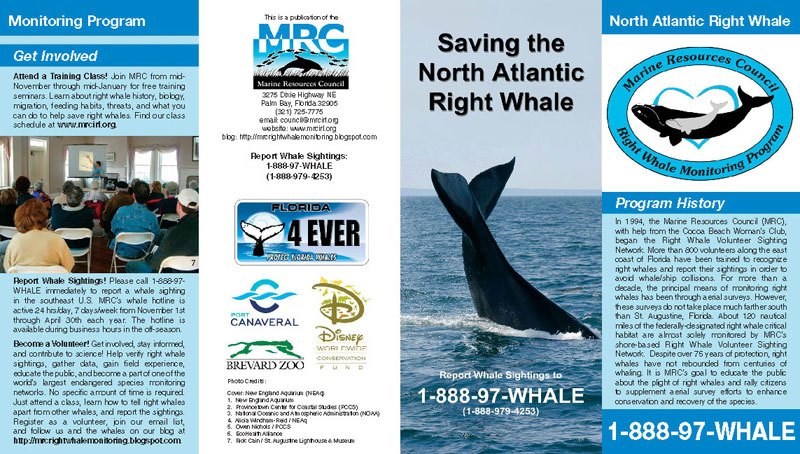
Photo: Marine Resource Council If you see a dead or beached whale please call: the Southeast Marine Mammal Stranding Hotline at (877) 433-8299.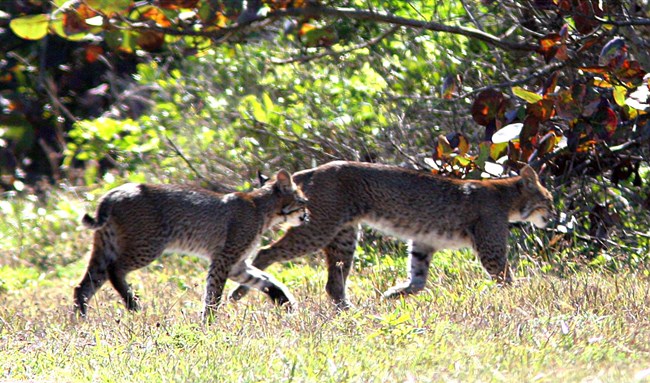
NPS Photo BobcatIf you are fortunate, you may catch a glimpse of a bobcat (Lynx rufus floridanus) darting across the park road. It is bigger than a housecat, tawny and spotted with black, with short ear tufts and a tail that is longer than its northern cousin, reaching 5 inches in length. This confuses many visitors who, accustomed to the short "bobtails" on northern bobcats, think they have seen a Florida panther. Observant visitors can spot bobcat tracks on the beach near the base of the dune. The tracks are distinctive - very round, usually with no claw marks, under 2 1/4 inches long and in a straight line. The primary prey are marsh rabbits, cotton rats (a small, dark, chunky rodent with a short tail that can sometimes be glimpsed darting about). Deer are also potential prey. Researchers are concerned that bobcats along the east coast of Florida are in danger of becoming genetically isolated from other bobcats. While it is possible for a Florida panther (Felis concolor coryi) to wander through, increasing development around the park provides a formidable barrier. Still, hope remains among visitors and staff of a panther sighting. Whenever a possible sighting is reported, a search is made for tracks or other signs, such as the distinctive way of killing a deer and covering the carcass. It is unfortunate that it and the red wolf (Canis rufus), another large predator that was eliminated from the area, are no longer a part of the ecosystem. These species could help to hold the large raccoon population in check. The jagarundi (Felis eyra) is another feline species that offers intriguing possibilities. Native to Mexico and a small section of the southwestern United States. it was reported in the park and refuge area 30 or so years ago. These were possibly escapees from a nearby animal park. No confirmed sightings have occurred since: however, biologists believe there is a small, established population on the west coast of Florida, fueling speculation that a few could still exist in the remote, central portion of Canaveral National Seashore. It is larger than a housecat (14 inches high at the shoulder), with short legs and a long tail, giving it the common name of otter cat. It is generally dull gray or rusty brown and is the least cat-like of all the felines. Its walking movements are described as weasellike, it readily takes to water, loves to climb and is active in the daytime. Keep you eyes peeled and camera ready!
Recent survey efforts by the University of Central Florida provide important information on formerly unrecorded or poorly understood mammal species at Canaveral National Seashore. The roundtailed muskrat (Neofiber alleni), a Florida endemic (found only in Florida) and Species of Special Concern, was formerly considered to be a resident of freshwater marshes and sugarcane fields until found in a salt hay (Paspalum-Distichlis) marsh along Mosquito Lagoon. Originally discovered at nearby Merritt Island, it is nocturnal, extremely elusive and thus seldom seen. An isolated population of the eastern woodrat (Neotoma floridana) was discovered in the Eldora hammock, spurring speculation that there may be other such populations in additional hammocks along the Indian River Lagoon. Analysis of barn owl pellets from the attic of the Eldora Statehouse, demonstrate that the marsh rice rat (Oryzomys palustris) is a significant component of the owl's diet. Other interesting mammals found at CNS are the gray fox (Urocyon cinereoargenteus), attractive spotted skunk (Spilogale putorius) and white-tailed deer (Odocoileus virginianus). Although small, the deer population seems to be increasing. 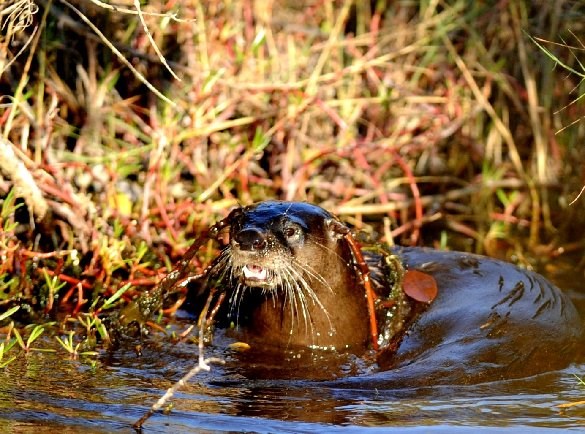
NPS Photo River OtterVisitors to the Canaveral National Seashore and Meritt Island National Wildlife Refuge are always delighted to see a river otter (Lutra canadensis). A good place to watch for it is along the refuge's Blackpoint Wildlife Drive. The otter population has been declining in Florida, with Canaveral NS and Merritt Island NWR considered key remaining areas. Unfortunately, one of the primary threats in the area is roadway traffic; occasional dead otters are seen along the roadways. 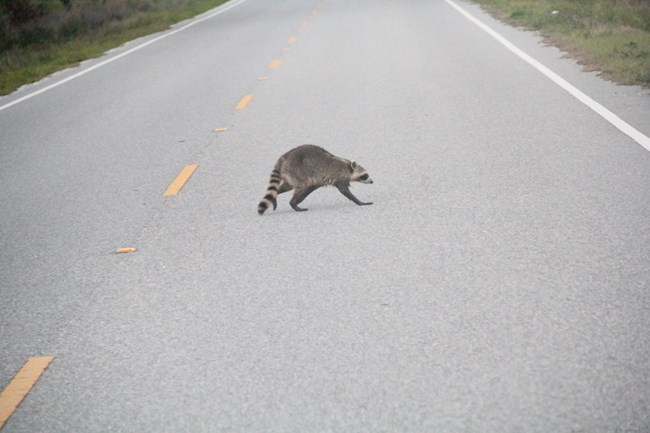
NPS Photo RaccoonThe most conspicuous mammal in the park is the raccoon (Procyon lotor), is a key part of the barrier island ecosystem. As one of the top predators in the food chain, the raccoon helps to control rodent and ghost crab populations. This helps sea turtles since ghost crabs are a major predator of sea turtle hatchlings. The raccoon also spreads plant seeds in its droppings and stimulates their germination as they pass through its digestive system.The raccoon population is flourishing for several reasons - natural predators, the red wolf and Florida panther are gone from the seashore area, food is abundant from natural sources and trash left by visitors, and dikes constructed for mosquito control have created convenient highways to navigate through marshy areas. The raccoon can be a pest, begging for food from visitors and stealing bait and fish from inattentive anglers. Sick animals are a threat to bite an outstretched hand. Please do not feed panhandling raccoons. Human food is not good for them and once they loose their natural fear of man it is often necessary to remove them for public safety. Raccoons pose another dilemma for park managers. Some individuals have learned to dig up eggs from the nests of sea turtles on the beach. Sea turtles are among Canaveral National Seashore's protected species. Before 1983, about 98% of the marine sea turtle nests deposited at the seashore were predated by raccoons. Clearly the park needed to take action. However, it was also important to allow the raccoon to fulfill its natural role in the ecosystem. The best action was to place flat wire mesh screens over nests to keep raccoons from digging up the eggs. Since that time, predation has been reduced to less than 20%. More information on sea turtle nest protection is included in the Animal/Reptile section. The study also revealed that, unlike those in northern climes, raccoons at the seashore breed most months of the year, complicating any removal efforts. Raccoons are much like humans - they are smart, adaptable, have incredibly dexterous paws, and eat a wide variety of foods. A few individuals have learned to tunnel under the screens. Some learn to bypass raccoon- proof trash lids. 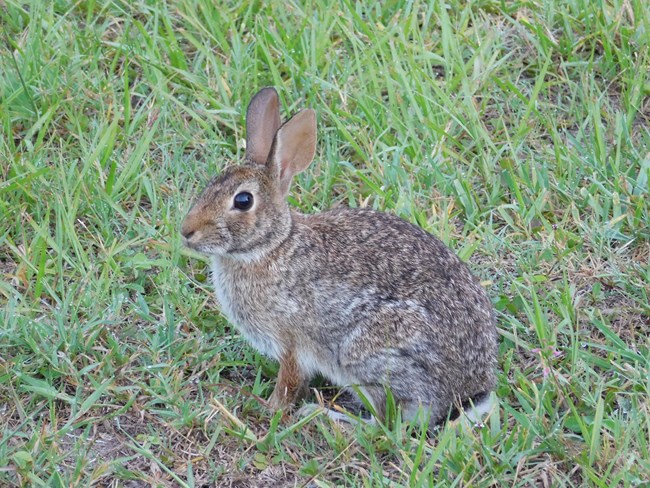
NPS Photo Eastern Cotton TailEastern Cotton tails (Sylvilagus floridanus) may be spotted in the Playalinda District of the seashore around the entrance station. They forage during dusk and dawn hours. They are solitary and will be spotted singularly. These quick runners can reach speeds of 18 miles per hour. Predators for the rabbit include hawks, owls, coyotes, and alligators. 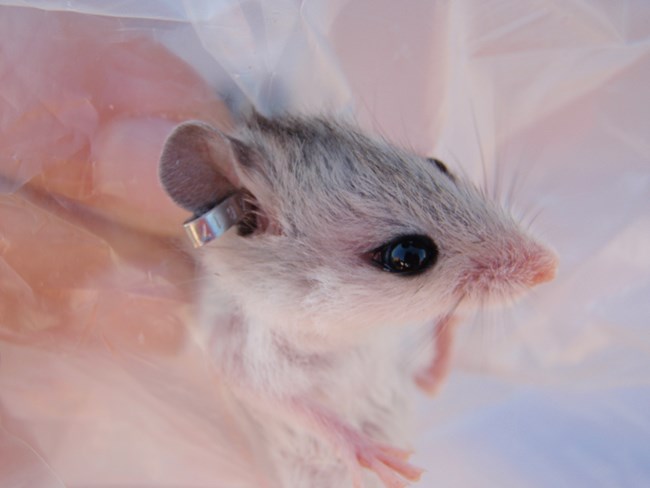
Beach Mouse (Threatened)Canaveral National Seashore is home to several unique and interesting semi-aquatic and terrestrial mammals as well. The tiny southeastern beach mouse (Peromyscus polionotus niveiventris) lives on and behind the dunes, relying heavily on sea oats for food. Federally designated as threatened, its entire range has been reduced to a 90 mile stretch along the east coast of Florida. This makes it extremely vulnerable to hurricanes which could wipe out the entire population. Managers are discussing such measures as live-trapping mice prior to a large storm to use as a reservoir for repopulating the dunes after the event or to establish a permanent captive breeding program. Other measures already being taken by CNS include construction of more than 20 boardwalks to protect the fragile dunes from foot traffic, installation of several miles of "snow" fencing to catch blowing sand and build up eroding dunes, and planting of vegetation to anchor the dunes, restore cover and provide food. This is also why rangers strictly enforce regulations that prohibit walking on the dunes or parking on vegetation along park roadways.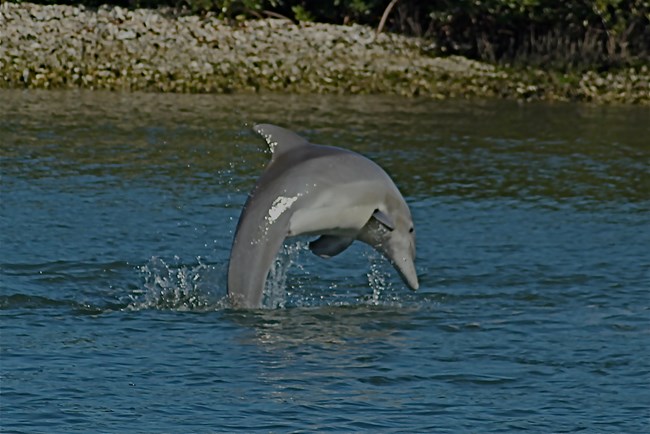
NPS Photo Bottlenose DolphinA common marine mammal also enjoyed by visitors is the bottlenose dolphin (Tursiops truncatus). Their distinctive crescent-shaped dorsal fins can often be seen breaking the surface of the water as they swim in the lagoon or offshore. The dolphin is sometimes mistakenly called a porpoise, a different animal that lacks the elongated snout, has a triangular shaped dorsal fin and is rare south of North Carolina. Scientistshave discovered an unusual trait about some of the dolphins in Mosquito Lagoon - a resident population of 200-800 individuals spend their entire lives in the lagoon rather than travel back and forth to the ocean. While they eat over 45 species of fish, pinfish, pigfish and mullet are their main prey. They are social animals and usually seen in small groups. They are thought to use sonar (sound waves) to locate prey and often hunt cooperatively, stunning fish and herding them into schools with their tails, then taking turns swimming through the schools to feed. Some anglers rely on dolphin to lead them to the fish. To the consternation of people harvesting blue crabs, some dolphins have learned how to remove baitfish from crab traps, significantly reducing crab harvest. Occasionally these marauders get entangled in the lines and drown. A disconcerting observation is about one-third of the dolphins in the Indian River Lagoon system exhibit skin lesions that may be related to pollution. |
Last updated: December 10, 2024
